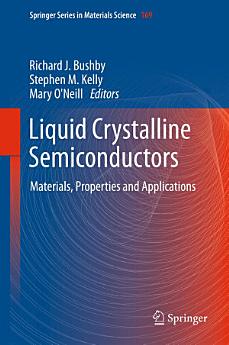Liquid Crystalline Semiconductors: Materials, properties and applications
Richard J. Bushby · Stephen M. Kelly · Mary O'Neill
2012년 11월 · Springer Series in Materials Science 169권 · Springer Science & Business Media
eBook
274
페이지
report검증되지 않은 평점과 리뷰입니다. 자세히 알아보기
eBook 정보
Liquid Crystals [LCs] are synthetic functional materials par excellence and are to be found in many types of LCDs; LCs self-assemble into ordered, but fluid, supramolecular structures and domains; they can be oriented in large homogeneous monodomains by electric and magnetic fields, Langmuir Blodgett techniques and also by self-orientation on suitable alignment layers; they are also anisotropic with preferred axes of light absorption, emission and charge transport with excellent semiconducting properties; they are soluble in organic solvents and can be deposited as uniform thin layers on device substrates, including plastic, by low-cost deposition processes, such as spin coating and doctor blade techniques; reactive mesogens [polymerisable LC monomers] can be photopatterned and fixed in position and orientation as insoluble polymer networks. LCs are increasingly being used as active components in electronic and photonic organic devices, such as Organic Light-Emitting Diodes [OLEDs], Organic Field Effect Transistors [OFETs], Thin Film Transistors [TFTs] and photovoltaic cells [PVs]. Such devices on plastic substrates represent a major component of the plastic electronics revolution. The self-assembling properties and supramolecular structures of liquid crystals can be made use of in order to improve the performance of such devices. The relationships between chemical structure, liquid crystalline behaviour and other physical properties, such as charge-transport, photoluminescence and electroluminescence are discussed and explained. For example, high carrier-mobility, polarised emission and enhanced output-coupling are identified as the key advantages of nematic and smectic liquid crystals for electroluminescence. The advantageous use of anisotropic polymer networks formed by the polymerisation of reactive mesogens [RMs] in devices with multilayer capability and photopatternability is described. The anisotropic transport and high carrier mobilities of columnar liquid crystals make them promising candidates for photovoltaics and transistors. The issues in the design and processing of liquid crystalline semiconductors for such devcies with improved performance are described. The photonic properties of chiral liquid crystals and their use as mirror-less lasers are also discussed.
이 eBook 평가
의견을 알려주세요.
읽기 정보
스마트폰 및 태블릿
노트북 및 컴퓨터
컴퓨터의 웹브라우저를 사용하여 Google Play에서 구매한 오디오북을 들을 수 있습니다.
eReader 및 기타 기기
Kobo eReader 등의 eBook 리더기에서 읽으려면 파일을 다운로드하여 기기로 전송해야 합니다. 지원되는 eBook 리더기로 파일을 전송하려면 고객센터에서 자세한 안내를 따르세요.









